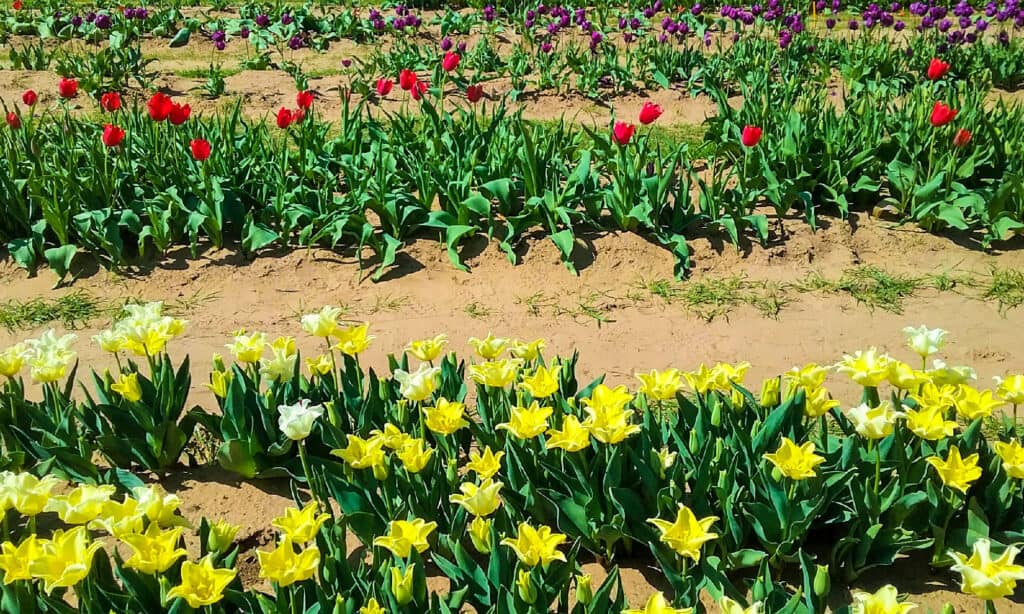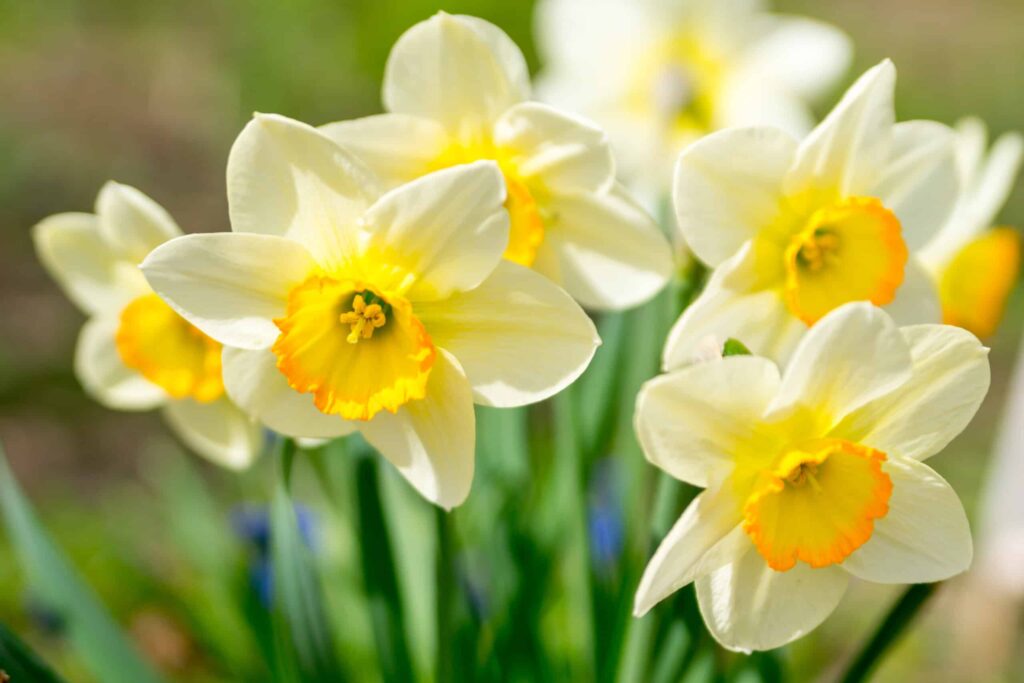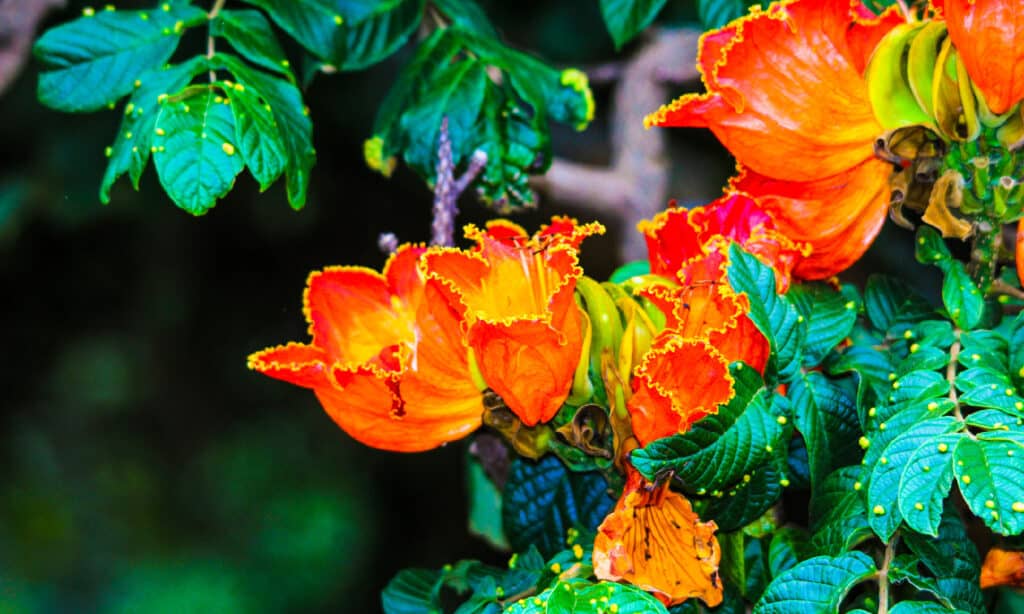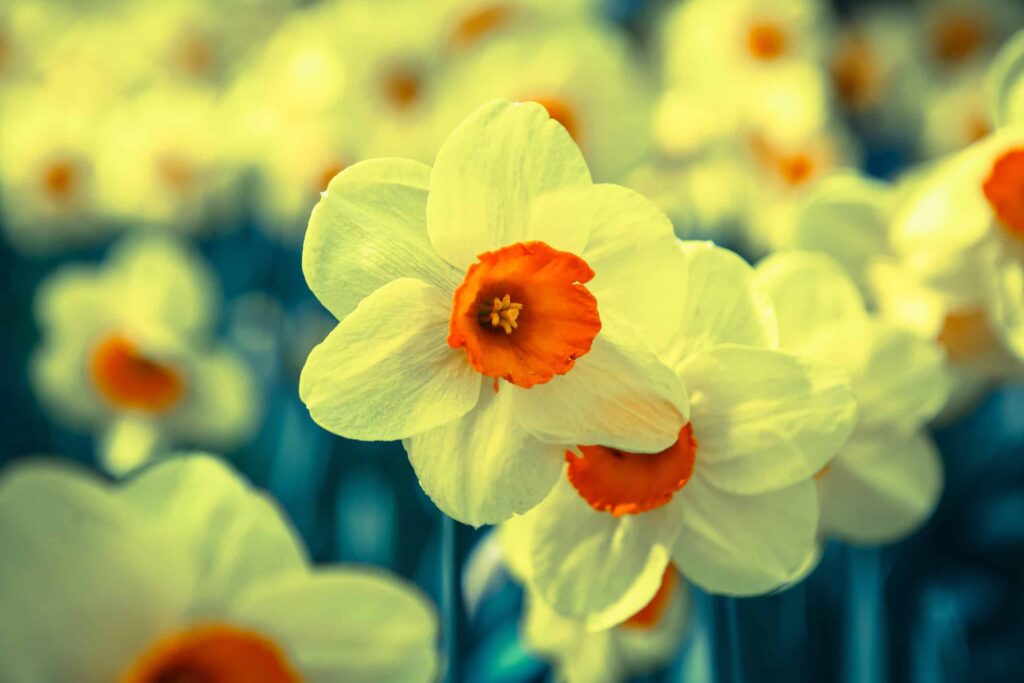Tulips and Daffodils bloom during the early spring and are some of the first flowers to peek up through the snow. They are excellent for naturalizing in large numbers and thrive in USDA hardiness zones with a cold winter. They both require a chilly period to encourage blooming. Folks in warmer climates often put these bulbs in the refrigerator to simulate a cold winter snap.
There are also several key differences between the two flowering bulbs, which we will discuss in further detail now.
Comparing Daffodil vs. Tulip

The daffodil is called many names in various parts of the world, including jonquil, narcissus, and daffodil.
©Susan Warren Photography/Shutterstock.com
| Characteristic | Daffodil | Tulip |
|---|---|---|
| Scientific Family | Amaryllis family, Amaryllidaceae | Lily family, Lilliaceae |
| Common Name | Daffodil, Narcissus, Jonquil | Tulip |
| Origins | Has been in cultivation since the 16th century. Native to Spain and Portugal. | Has been in cultivation since the 16th century. Native to Kazakhstan, who brought it to Turkey. |
| USDA Hardiness Zone | Zones 3-8 | Zones 3-7 |
| Uses | Was previously used as a medicinal plant. Modern-day uses are primarily as cut flowers, potted plants, or naturalized in large areas. | The most common use is as a border or bedding plant. Sometimes naturalized in larger areas or cutting gardens. Rarely used in cosmetics or culinary. |
| Description | One blossom per stem, 6 lobes, bell-shaped crown with frilly edges. | A single or double blossom per stem, 3 petals, and 3 sepals, cup-shaped flower, long broad leaves. |
| Fragrance | A green floral scent with a trace of hyacinth. | A green apple-like scent. |
| Size | Wide variety of sizes, from 5″ blooms on 2-foot stems to 1″ blooms on 2″ stems. | From 6″ to 2 feet |
| Growing Requirements | Full sun. 6 hours or more of direct sunlight. Well-drained soil. Plant in the fall, 4 weeks before the first freeze. Plant the bulb two times as deep as the bulb is high, with the pointy side up. | Full sun to part sun. Plant 8 weeks before the first freeze in the fall. Plant 4 inches apart at a depth 3 times the bulb’s height, with the pointy side up. |
| Colors | White, pale pink, pale orange, every shade of yellow. | Green, orange, pink, purple, red, white, yellow, and multi-colored. |
| Bloom time | Early varieties bloom from February to March. Mid varieties bloom from March to April. Late varieties bloom from April to May. If you plant all three in a mixed bed, you will have daffodil blooms from February through May. | Early varieties bloom from March to April. Mid varieties bloom from April to May. If you plant both in a mixed bed, you will have tulip blooms from March to May. |
Key Differences Between a Daffodil and a Tulip
The key differences between a daffodil and a tulip are scientific family and name, colors, appearance, and fragrance. Other differences include growing requirements, deer and rabbit resistance, uses, and bloom time.
Daffodil vs. Tulip: Scientific Family and Names

Tulips are members of the Lily family.
©iStock.com/ANDA MIKELSONE
Daffodils are a member of the amaryllis family. Members of this family have underground bulbs or stems and strap or lance-like leaves.
Tulips are members of the Lily family. In this family, you will find huge flowers. You will also see flower parts arranged in threes, such as the tulip’s three sepals and three petals.
The daffodil is called many names in various parts of the world, including jonquil, narcissus, and daffodil. The common name tulip is the only one used across the globe.
Daffodil vs. Tulip: Colors

Daffodils love the full sun!
©Arvind Balaraman/Shutterstock.com
Daffodils are best known for their vibrant yellow blooms. You can find a daffodil in every shade of yellow. Growers have used selective breeding to create pale orange, pink, and white daffodils.
Tulips are best known for their bright and vibrant colors. They come in purple, pink, red, yellow, orange, green, white, and even multi-colored stips and whorls.
Daffodil vs. Tulip: Appearance and Fragrance

Tulips have one or two blossoms per stem and always come with three petals and three sepals.
©iStock.com/Regan Ledbetter
Daffodils usually have one blossom per stem, although newer cultivars have come with a cluster of daffodils on one stem. They have six lobes, a bell-shaped crown, and scalloped edges. The fragrance of daffodil can best be described as flowery and bright green with a hint of sweet hyacinth.
Tulips have one or two blossoms per stem and always come with three petals and three sepals. The flowers are cup-shaped and large. The leaves are blueish in color, long and strap-like. The fragrance of tulip is similar to a sweet apple mixed with a fresh green scent.
Daffodil vs. Tulip: Growing Requirements

Daffodils are poisonous to animals, your pets included.
©Province_photo/Shutterstock.com
Both daffodils and tulips need a cold winter to encourage blooming. They need a period below 45 degrees Fahrenheit to bloom in the spring. If you live in a hot area, you can dig up your bulbs and store them in a refrigerator over winter.
These bulbs prefer a well-drained planting site, or they will rot, so be sure to incorporate organic matter or sand into thick or clay soil. Daffodils and tulips enjoy full sun, with a minimum of 6 hours of sun per day. Tulips are slightly more shade tolerant than daffodils.
Plant daffodils in the fall, 2-4 weeks before the first winter freeze. Plant tulips eight weeks before the first winter freeze or very early in the spring as soon as the ground thaws out enough to dig a hole.
Daffodil vs. Tulip: Deer and Rabbit Resistance

Tulips are slightly more shade tolerant than daffodils.
©iStock.com/Ansley Kynes
One primary consideration is where to plant a tulip bulb. If you live in an area with rabbits, deer, mice, elk, rats, voles, squirrels, moles, or chipmunks, be advised that tulip bulbs, leaves, and flowers are a favorite delicacy of these animals. You can plant the bulb underground, surrounded by a chicken wire cage or even sharp gravel to discourage digging. You can plant tulips behind a fence or in a moveable pot to keep the plant safe after blooming.
For daffodils, animals are not an issue. The plant is poisonous to animals, your pets included. For this reason, deer, rabbits, and other plant-munching creatures will steer clear of your daffodil’s bulbs, flowers, and leaves.
Daffodil vs. Tulip: Uses

The daffodil is best suited for naturalizing in a large meadow or lawn due to its narrow leaves that disappear into the surrounding foliage.
©hurricanehank/Shutterstock.com
Once upon a time, both daffodils and tulips were used for medicinal, cosmetic, and even culinary purposes. Today we only use these plants as garden ornamentals.
Of the two, the daffodil is best suited for naturalizing in a large meadow or lawn due to its narrow leaves that disappear into the surrounding foliage. It also lasts ten days as a cut flower in a vase.
Tulips are the best suited for the back of a border because of their tall height. Emerging perennials will cover the broad leaves in the spring to keep your garden looking neat. Tulips last five days as a cut flower if you take them indoors.
Daffodil vs. Tulip: Bloom Time

Tulips come in two varieties, early and mid.
©iStock.com/Iva Vagnerova
Daffodils come in three varieties, early, mid, and late. If you plant all three of these together, you will have blooms from early February to late May.
Tulips come in two varieties, early and mid. If you plant both of them, you will have tulips blooming from mid-march to mid-may.
The photo featured at the top of this post is ©
Thank you for reading! Have some feedback for us? Contact the AZ Animals editorial team.







